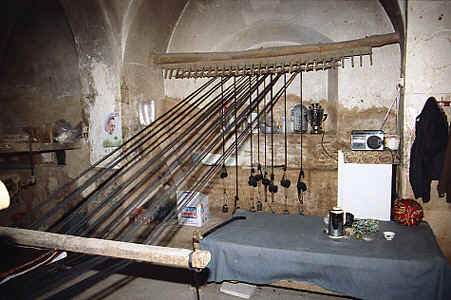Yazd's Handicraft
Carpet weaving is Yazd's principal handicraft. In 1996, there were 65000 carpets weaving looms at work across the province and some 30,000 weavers were engaged in this old artistic and economic activity. Five square meters of carpet is woven by each weaver per year. Carpets are usually made in 3x4, 2.5x3.5, 2.5x2.5, and 1x1 sizes (in meter). Other sizes, however, may be woven according to the client's order. “Herati”, “Fish”, “Forest Lord” and “Kermanian” are the main designs of Yazd carpets.
Zilu weaving
Zilu is a kind of light hand-woven carpet, the weaving of which provides hundreds of families their livelihood. The provincial Zilu-weaving center is Meibod, in which the craft has been traced to ancient era. This light carpet has proven to be one of the most suitable and most enduring floor coverings, especially in desert areas.
Famous names in this hand-made traditional industry include: Naftal, Pert Toureh, Zolfak, Rokneddin, small eight-sided and large eight-sided zilus, Banrumi and Kelid. The oldest zilu dating back to many centuries ago, is presently available for visiting in Congregational Mosque of Meibod.
Shar-bafi (light decorated cloth weaving)
The products of this material-weaving industry are multifarious. Shar weavers use a wooden loom, whose size varies proportionately with the dimensions of final material. At first, it is said, housewives began the industry and maybe it was them who invented the loom. Later, however, men developed an interest in this light home-based industry and gradually, shar-baf workshops were established. The clicking sound of the looms of these workshops had filled the air of many of Yazd's winding alleys, yet.
Shar loom is made of two rolls, a number of pedals, a combing device and some small and larger shafts. With such simple looms, the talented people of Yazd produce very beautifully designed materials like Terma, Velvet, a special handkercheif, bed-covers, prayer mats and blankets.
Earthenware and Ceramics
Pottery is among the oldest and, perhaps, the first earth-related art of man. It dates back to over 6000 years B.C. in Iran, and Meibod has since been the center of pottery in Yazd province. Earthenware are termed “Kevareh” in local dialect. A large part of the Meibod earthenware are used inside the province and a part of it is exported to domestic and foreign markets. Meibod's original designs of earthenware and ceramic known as “bird and fish” and “Khorshid Khanom” (or the sun lady) are quite famous. Meibod's pottery and ceramics are categorized in three types: Simple non-enameled earthenware, Enameled ware, and tile and ceramic.
Giveh weaving
Giveh is a light and very easy-to-wear kind of local shoes, in which a special material, woven by rural women, is used instead of leather. A giveh's sole, of course, is made of a very durable material. Usually, rural women weave the outer part of the giveh in their leisure time, employing very simple tools. The sole is made by men. Presently, giveh weaving is pursued as a small home-based industry in places such as Taft, Mehriz, Nir, Khunza, Baqdad Abad and Bahabad.
Metal forgery
Yazd's old blacksmiths still continue to make gadgets such as scales, sugar cube cutters, knives, chains, pincers and locks by using simple tools such as a hand-blower, a nipper, and a hammer. Mehriz, Aqda,Nadoushan, Sakhvid, Ardakan and Khezrabad are centers of traditional ironworks.
Tile Making
This craft has a 700 years history behind it in Yazd province. The artists at first decide on the shape and size of the tiles and then proceed with drawing (upon them) and enameling before baking the tiles.
Yazd tiles include: Kamak, Shabakeh (network), Hexagon, Marginal, Akmond, Jouk and Seven-color tile.
Serishom-making (traditional paste)
Serishom is a paste made of animal fat. To make it, animal skin, bones and fat are placed in a special pot and cooked into a thick liquid. The liquid is later spread on special surfaces in order to dry up for packing. To use it, the serishom bar is soaked in water top produce a very strong adhesive paste, which is mainly used in inlaid works. Mehriz has been a traditional center for Serishom-making.
Other Crafts
Engraving (carving beautiful designs on wares and frames with very fine and tiny hammers), glassworks, weaving floor mats and other kinds of mats, leatherworks, and hair spinning and felt works are other handicrafts and small traditional industries Yazd.
Yazd's handicraft products maybe purchased in Khan Bazaar Complex, Handicraft Industries Center's Store and privately owned local stores production sites.
Yazd Sweets
Yazd is also famous for its very tasty sweets, which may, at first, taste a bit too sweet to non-Iranians, as they are so very sweet indeed! Baqlava (an oily nuts sweet usually cut in diamond shapes), Lows-Bidmeshk (Musk-willow scented lozenges), Lowz-Pesteh (pistachio lozenges), Lowz-Nargil (coconut lozenges), Qottab and Pashmak (cotton candy), sweet rice breab, almond cookies, etc. are popular sweets of Yazd. Also, Yazd's Sohan (a special flour and nuts sweet) and its traditionally extraced herbal waters are quite famous across the country.

Photo by: Masoud Soheili

